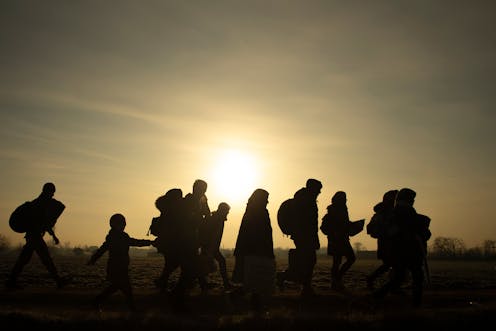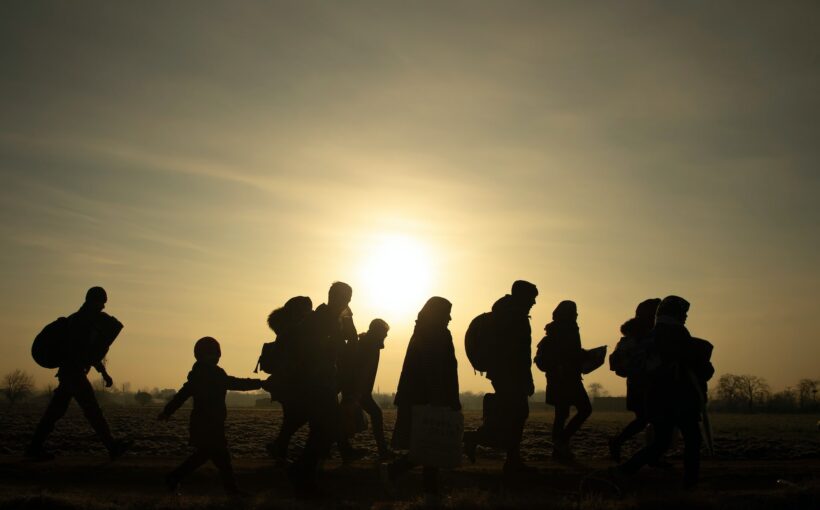
The UK’s home secretary, Suella Braverman – the minister responsible for setting immigration policy – has said the United Nation’s refugee convention is not “fit for our modern age” and should be renegotiated.
As researchers of migration at the United Nations University, we know the importance of the convention – a landmark agreement that underpins the human rights of people around the world. Braverman’s comments to an American think tank do not reflect reality.
The refugee convention (formally, the 1951 Convention Relating to the Status of Refugees) was established by the UN to protect the millions of people displaced in Europe after the second world war. It was expanded beyond Europe with its 1967 protocol, which applied the convention’s protections to all refugees around the world.
The convention lays out the definition of who counts as a refugee. It also sets out their rights (such as to housing, work and education), and how states are obliged to support them. For the 149 countries who have joined (including the UK), it is the legal basis for how they create policy and support refugees.
A central principle of the convention is what is known as “non-refoulement”. This means a refugee cannot be sent to a country where they might suffer persecution, nor to a country which might send them to such a country. When groups such as the UN refugee agency say the UK’s policy to deport asylum seekers to Rwanda violates international law, this is the law they are referring to.
Who is a refugee?
To be considered a refugee, according to the convention, a person must have crossed an international border due to persecution (and a lack of protection from their own state).
While the convention does not define “persecution”, the UN refugee agency describes it as a “threat to life or freedom”, specifically due to reasons of race, religion, nationality, membership of a particular social group, or political opinion.
The lack of clear definitions for some of these terms has been seen as a shortcoming of the convention. It can lead to variation in how states interpret what should be considered “persecution”.
Braverman waded into this, arguing that the modern interpretation of persecution is “more akin” to discrimination: “We will not be able to sustain an asylum system if in effect, simply being gay, or a woman, and fearful of discrimination in your country of origin is sufficient to qualify for protection.”
Discrimination and persecution
In her speech, Braverman cited claims made by the Centre for Policy Studies that at least 780 million people might be eligible for refugee status under the convention. This figure appears to be partly based on summing the number of people living in countries where homosexuality is outlawed.
But it is highly unrealistic that all of these people will move and seek asylum elsewhere. We know that many people in such situations never leave their own countries, because it is often very difficult, dangerous and expensive to do so.
Nevertheless, Braverman suggested that the convention provides overly generous protection and will lead to an unsustainable caseload of refugees. This is misleading for several reasons.
The convention itself does not explicitly address gender identity or sexual orientation as grounds for persecution, so it’s largely up to national governments how they assess such cases. The UK Home Office states in its guidance for asylum case workers that “someone could face societal discrimination but this will not amount to persecution […unless…] the discrimination has resulted in sufficiently serious consequences for the person concerned”.
Braverman’s comments downplay the oppresion that LGBTQ+ people face in many countries, where they are at risk of violence, imprisonment, or even death.
They also overplay the role of LGBTQ+ people in asylum migration. In reality, cases related to sexual orientation make up a small proportion of asylum claims in the UK: only 1,334 people, or 2% of all asylum applications, in 2022.
Misleading migration figures
When it comes to migration, politicians have a tendency to use and reproduce, or misinterpret numbers which are not necessarily based upon reliable or rigorous research.
It is not true, for example, that North America and Europe are currently witnessing record numbers of refugees. Recent research shows that since the creation of the refugee convention in 1951, the number of refugees worldwide has fluctuated between 0.1% and 0.3% of the global population. At the end of 2022 there were approximately 35 million refugees out of a total of 108 million people who were internally or internationally displaced.
Some people claim that climate change will lead to billions of climate migrants – the convention does not address environmental factors, so the term “climate refugee” does not technically exist. Additionally, these figures are based on assumptions that everyone affected will move elsewhere, something that our own research has shown to be false. This simplistic understanding lies behind the kind of alarmist and unsubstantiated figures underlying Braverman’s calls for changing the convention.
Braverman’s speech elicited rare pushback from the UN, who called for “stronger and more consistent” application of the convention – not a renegotiation. We agree. Focusing on any numbers, however true, obscures the fact that refugees are people with rights, hopes, dreams and aspirations. It is thanks to the refugee convention that they are able to access their human rights, and rebuild their lives in safety and dignity.
![]()
The authors do not work for, consult, own shares in or receive funding from any company or organisation that would benefit from this article, and have disclosed no relevant affiliations beyond their academic appointment.



